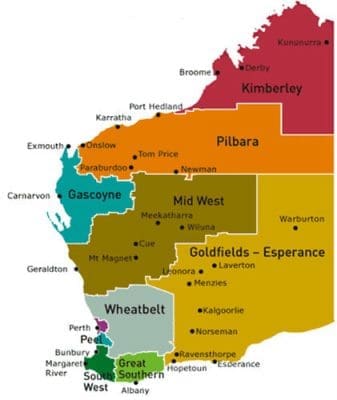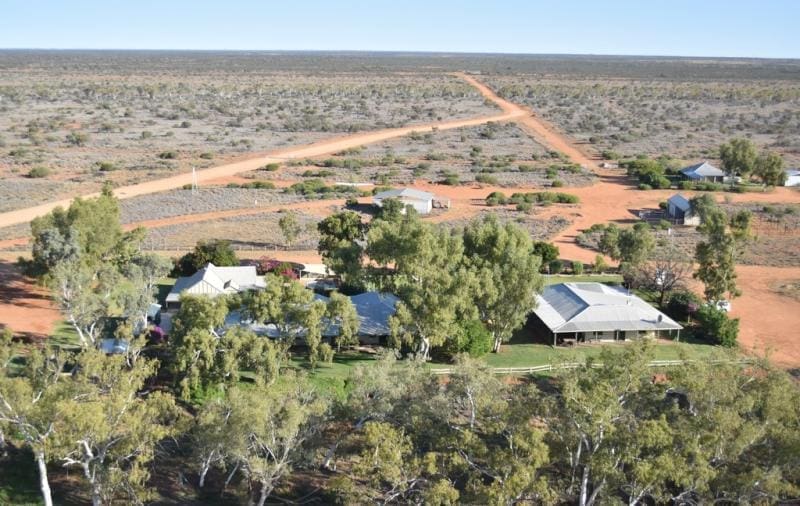THIS week completes our two-part Western Australia grazing property scrutiny, with a closer look at the state’s Pilbara and Gascoyne regions.
Last week’s property report focused on WA’s Goldfields region (see regional map)

DOL regions map
Under Western Australian legislation, the Pastoral Lands Board has the authority to set carrying capacity on pastoral leases (Click on this link to see the relevant passages of legislation in the WA Land Administration Act).
According to Darren Tapscott, a valuer and a director of the newly formed YieldWA valuation group, the ratings have been put in place years ago by the Department of Agriculture. They are enforced at will – not necessarily all the time – by the Pastoral Lands Board.
“In some areas, those potential carrying capacities have not been updated for up to 50 years,” Mr Tapscott said.
“They are no longer a reflection of what’s actually happening on the ground. Unfortunately, lending institutions and banks use these rates to do their sums on, because they are tangible, but it certainly creates an issue,” he said.
“Very few pastoral leases, particularly the further north you go, run those numbers. It is usually well in excess of that.”
Mr Tapscott said the WIWO values of cattle stations across northern WA had lifted significantly over the last two or three years.
“That has been driven primarily by the increase in livestock prices. What we are now starting to see is a flow-on effect to the lease improvement side of the equation.”
Pilbara seen as the stand-out
Elders’ pastoral sales specialist Greg Smith likens WA pastoral leases to the vast flat country in western New South Wales known as the Hay Plains, and the Mitchell/Flinders grass downs country of Queensland.
He said the Pilbara had always been highly sought-after.
“In terms of property demand, the Pilbara is the stand-out area. While it does not have the Kimberleys’ higher and more reliable rainfall, the region has had a pretty good run of seasons. It has a tropical rather than a temperate climate and rainfall pattern, and has been established with cattle for longer,” he said.
While land values in the Pilbara have risen more than other areas, Mr Smith admitted it was probably on the back of stronger cattle prices.
“Properties are bigger and running more cattle. However, property prices have been distorted by the amount of mining activity that’s gone on. At present, it is well valued, but perhaps slightly over-valued.”
Mr Tapscott believes land values in the Pilbara have room to move, but said they are usually 20 percent below Kimberley prices, on the back of higher rainfall.
Benchmark sales
In December 2014, one of Australia’s largest cattle stations, the 6395sq km Balfour Downs east of Roy Hill, and Wandanya Stations in the Pilbara sold to wealthy Chinese businessman Xingfa Ma for between $18 and $20m, including 15,000 head of cattle.
Mr Tapscott said there had been some very good sales over recent years and places like Balfour Downs that sold well would be worth significantly more today.
“If cattle numbers were roughly the same, I estimate Balfour is worth in excess of $30 million today,” he said.
Geraldton-based rural property valuer Russell Coupe said Pilbara land values had improved and could increase substantially because the stations are large and viable and beef prices are so strong.
“I can’t give a beast area value in the region because there are no standard figures available. One station sold recently revealing very high beast-area values, but cattle numbers all vary so much,” he said.
Elders’ Greg Smith said interest in the Pilbara was coming from both corporates and farming families.
“Low interest rates aren’t a factor, because most of the money spent is not borrowed money. To some extent the market is distorted, because many Pilbara pastoral stations are owned by the big mining companies, such as BHP and Rio Tinto, indigenous land corporations and high net-wealth individuals like Gina Rinehart and Andrew Forrest – who both grew up in the Pilbara.”
“The availability to secure a good parcel of land is rare with supply outstripping supply.”
Mr Tapscott doesn’t believe Pilbara land prices have been distorted due to mining.
“They may well have been when mining companies were actively buying years ago. Under law, properties owned by mining companies must still run as pastoral leases. Some of those properties have very good infrastructure on them as a result of being owned by entities who are very cashed-up. As a result, the sub-leases on those properties are well sought after, but it hasn’t had a significant impact on market values.”
Gascoyne a ‘pure pastoral play’
When it comes to the Gascoyne in Western Australia’s north-west (refer to regional map published above), Elders’ Greg Smith said it is very difficult to compare apples with apples.
“Generally speaking you would say the Gascoyne (which has a moderate arid tropical climate) is not as reliable as some of the Pilbara for grazing purposes. There is no mining, so there has never been competing interests. It has always been assessed for its pastoral value alone.”
In terms of ‘rated carrying capacity’, Mr Smith said the northern Gascoyne is similar to the Pilbara, but the Pilbara is more tropical and has had an earlier establishment and spread of buffel grass.
“Three years ago, 7-8 large, very good pastoral leases in the area were sold by administrators for absolute bargain prices following the live export ban”
“Pastoral station prices in the Gascoyne have remained fairly static. It wasn’t that long ago that many were virtually given away,” he said.
“Three years ago, seven or eight large, very good pastoral leases in the area were sold by administrators for absolute bargain prices following the live export ban. While prices have lifted since those forced sales, overall property prices have not risen dramatically over a 15 year period.”
One of the region’s most significant and recent sales was the 500,000ha Brickhouse and Minilya Stations, located north of Carnarvon with 60km of Indian Ocean frontage. They sold to WA mining magnates Andrew and Nicola Forrest for more than $10m in August 2015.
Another was the 148,003ha Carnarvon cattle station Boolathana which sold for around $4.75m WIWO in November last year.
Mr Tapscott described the price as a massive improvement compared to previous decent-sized sales in the region and admitted it might be an indicator of what’s to come.
“Land values in the region should continue to lift. The caveat is livestock prices. As long as cattle prices hold, there will be a continual lift in the land component of pastoral leases in the Gascoyne.”
Mr Coupe agrees that land values in the Gascoyne are recovering because of beef prices.
“In the western Gascoyne there are better prospects due to buffel grass growth, better rainfall and the larger property size. However, once you get into the Upper Gascoyne, you encounter the same problem as the Goldfields (see last week’s report) – depleted rangelands, low and erratic rainfall and properties that are not well suited to running cattle.”
“While land values will probably rise on the back of high stock prices, high cash flow, greater confidence and liquidity to invest, it will not change the long term future in a lot of the country,” Mr Coupe warned.

579,206ha Bidgemia Station will provide something of a benchmark for future land values in the Gascoyne.
Mr Smith said Elders had just listed two new quality pastoral stations in the Gascoyne which are likely to provide something of a benchmark for future land values:
- 579,206ha Bidgemia Station (including Lyons River Station) – an impressive beef breeding enterprise that carries 11,000 head of cattle.
- 307,012ha Maroonah and Mangaroon Pastoral Stations – offered as one beef enterprise with a 7300-head Droughtmaster herd.
Mr Smith said the two properties are for sale by Expressions of Interest and it will be interesting to see where the market values them.
- Beef Central’s comprehensive “Recent property sales” tables will provide a report on Bidgemia and Maroonah/Mangaroon, once an outcome is known.
- Click here to access Recent property listings.



HAVE YOUR SAY